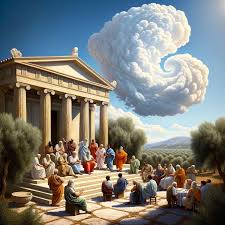Introduction
Lessons of educational history has undergone significant transformations throughout history, yet many of its core principles remain surprisingly consistent. As we navigate the complexities of modern education, understanding its historical roots can provide valuable insights into how we can improve and innovate. This article explores the evolution of education, highlighting key lessons from the past that can help shape a better future for learning.
The Foundations of Ancient Education

Education in Ancient Egypt
Ancient Egypt laid some of the earliest foundations for formal education. The education system was primarily designed for the elite, focusing on training scribes who played a crucial role in administration and record-keeping. Temples served as educational centers where young boys learned writing, mathematics, and religious texts.
The Legacy of Egyptian Education
The meticulous record-keeping and the development of writing systems in ancient Egypt highlight the importance of literacy and administrative skills. These elements underscore the need for a strong educational foundation that includes essential life skills.
The Greek Philosophical Schools
The Academy of Plato

Founded around 387 BC by the philosopher Plato, the Academy in Athens is one of the earliest known higher education institutions. Plato’s approach emphasized critical thinking and the pursuit of knowledge for its own sake, rather than for practical applications.
Aristotle’s Lyceum
Aristotle, a student of Plato, established the Lyceum around 334 BC. Unlike the Academy, the Lyceum incorporated empirical research and observation into its teachings, laying the groundwork for the scientific method.
Roman Education and Its Impact
The Roman Education System
Roman education borrowed heavily from Greek traditions but focused more on practical skills for public service. The Romans established schools that taught reading, writing, arithmetic, and rhetoric—skills essential for participation in civic life.
Influence on Modern Education
The Roman emphasis on rhetoric and public speaking has endured in modern education. This highlights the importance of developing communication skills alongside academic knowledge, preparing students for active participation in society.
The Rise of Monastic and Cathedral Schools
Education in the Middle Ages
During the Middle Ages, monastic and cathedral schools became the primary centers of learning in Europe. Monks and clergy were often the only literate members of society, and these institutions preserved and transmitted knowledge through the Dark Ages.
The Role of Religious Education
The focus on religious education during this period underscores the significance of moral and ethical instruction. It also highlights the role of educational institutions in preserving cultural heritage and fostering intellectual continuity.
The Islamic Golden Age
The House of Wisdom
Established in Baghdad during the Abbasid Caliphate, the House of Wisdom was a major intellectual hub where scholars from various cultures translated and preserved ancient texts. This period saw significant advancements in science, mathematics, medicine, and philosophy.
Lessons from the Islamic Golden Age
The multicultural and interdisciplinary approach of the House of Wisdom demonstrates the value of diversity in education. Collaborative efforts across cultural and disciplinary boundaries can lead to significant intellectual and scientific breakthroughs.
Also read Building Resilience: Learning to Bounce Back from Challenges and Setback
The Renaissance and Humanist Education
The Humanist Movement
The Renaissance brought a renewed interest in classical knowledge and the humanities. Humanist scholars emphasized the study of literature, history, and ethics, advocating for an education that developed well-rounded individuals.
The Birth of Modern Universities
The establishment of universities in medieval Europe, such as the University of Bologna and the University of Paris, marked the beginning of higher education as we know it. These institutions formalized curricula and degrees, setting standards for academic achievement.
The Enlightenment and the Age of Reason
The Spread of Enlightenment Ideas
The Enlightenment, or the Age of Reason, was characterized by an emphasis on reason, science, and individualism. Thinkers like John Locke and Jean-Jacques Rousseau challenged traditional educational practices, advocating for methods that fostered critical thinking and personal development.
Impact on Education
The Enlightenment’s focus on rationality and empirical evidence laid the groundwork for modern educational theories. The period’s emphasis on individual rights and self-determination also influenced contemporary views on education as a means of personal and societal improvement.
Industrial Revolution and Public Education
The Need for Mass Education
The Industrial Revolution brought about significant social and economic changes, necessitating a more educated workforce. This led to the development of public education systems aimed at providing basic literacy and vocational skills to the broader population.
The Birth of Compulsory Education
Compulsory education laws were introduced in the 19th century, ensuring that all children had access to education. This shift highlighted the importance of education as a public good and a fundamental right.
Progressive Education and Its Pioneers
John Dewey and Experiential Learning
John Dewey, an influential American educator, advocated for experiential learning, where students learn through experience and reflection. His ideas emphasized the importance of active participation and the integration of education with real-life experiences.
Maria Montessori and Child-Centered Education
Maria Montessori developed an educational approach that focused on the individual needs and interests of each child. Her method emphasized hands-on learning, self-directed activity, and collaborative play, promoting independence and creativity.
The Digital Age and E-Learning
The Rise of Technology in Education
The advent of the internet and digital technology has revolutionized education, making information more accessible and enabling new forms of learning. Online courses, virtual classrooms, and educational apps have transformed traditional teaching methods.
Challenges and Opportunities
While technology offers numerous benefits, it also presents challenges such as digital divides and the need for digital literacy. Balancing technological integration with traditional educational values is crucial for creating effective learning environments.
The Importance of Lifelong Learning
Adapting to a Changing World
In today’s rapidly changing world, the concept of lifelong learning has gained prominence. The need to continuously acquire new skills and knowledge is essential for personal and professional development.
Creating a Culture of Learning
Educational institutions play a key role in fostering a culture of lifelong learning. Encouraging curiosity, critical thinking, and adaptability can help individuals thrive in an ever-evolving landscape.
Addressing Educational Inequality
Historical Roots of Inequality
Educational inequality has deep historical roots, often tied to socio-economic status, race, and gender. Understanding these historical contexts is essential for addressing contemporary disparities in education.
Strategies for Equity
Implementing policies that promote access to quality education for all students is critical. This includes addressing barriers such as funding disparities, resource allocation, and systemic biases.
The Role of Teachers
Educators as Facilitators
The role of teachers has evolved from mere transmitters of knowledge to facilitators of learning. Effective educators inspire curiosity, foster critical thinking, and support students’ individual learning journeys.
Professional Development
Ongoing professional development is crucial for teachers to stay current with educational trends and methodologies. Investing in teacher training enhances the overall quality of education.
Engaging Parents and Communities
Collaborative Efforts
Education is a collaborative effort that involves parents, communities, and schools. Engaging parents and communities in the educational process can create a supportive environment that enhances student learning.
Building Partnerships
Building partnerships between schools and community organizations can provide additional resources and opportunities for students. These collaborations can enrich the educational experience and address broader societal issues.
The Future of Education
Embracing Innovation
The future of education lies in embracing innovation while staying true to fundamental educational principles. This includes integrating technology, fostering creativity, and promoting inclusive practices.
Preparing for Future Challenges
As the world continues to evolve, education must adapt to new challenges such as climate change, globalization, and technological advancements. Preparing students to navigate these complexities is essential for their success.
Conclusion
The history of education is a testament to humanity’s enduring quest for knowledge and self-improvement. By examining the lessons of the past, we can better understand the present and pave the way for a more equitable and innovative future. Education is not just about imparting knowledge; it is about inspiring curiosity, fostering critical thinking, and empowering individuals to make a difference in the world.
FAQs
1. How did ancient civilizations influence modern education?
Ancient civilizations, such as Egypt, Greece, and China, laid the foundations for formal education by establishing schools, developing writing systems, and emphasizing critical thinking and moral development.
2. What impact did the Enlightenment have on education?
The Enlightenment emphasized reason, science, and individualism, influencing modern educational theories that prioritize critical thinking, empirical evidence, and personal development.
3. How did the Industrial Revolution change education?
The Industrial Revolution necessitated a more educated workforce, leading to the development of public education systems and compulsory education laws that ensured access to basic literacy and vocational skills.
4. What is the significance of progressive education?
Progressive education, championed by figures like John Dewey and Maria Montessori, emphasized experiential learning, child-centered approaches, and the integration of education with real-life experiences.
5. How can we address educational inequality?
Addressing educational inequality requires implementing policies that promote access to quality education for all students, addressing funding disparities, resource allocation, and systemic biases. Building partnerships between schools and communities can also help create supportive and inclusive learning environments.


